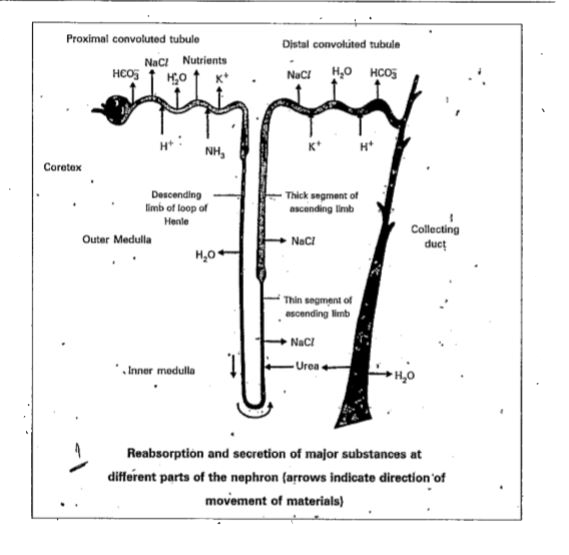Write the path-way of urine. Solution in Telugu
Video Solution
Text Solution
The formation of urine involves three main processes namely
1) Glomerular filteration
2) Selective reabsorption
3) Tubular secretion.
1) Glomerular filteration : It is first step in urine formation. The process of filteration of blood, which occurs between glomerulus and lumen of the Bowman.s capsule due to difference in netpressure is called glomerular filteration.
The hydrostatic pressure of blood while flowing in the glomerulus is 60 mm Hg. It is opposed by glomerular colloidal osmotic pressure of 32 mm Hg and Bowman.s capsule hydrostatic pressure of 18 mm Hg.
The net filterate pressure is 10 mm Hg (60-32+18=10). This clauses the filteration of blood through the 3 layered filterate membrane formed by endothelium cells of glomerular capillary together with the basement membrane and podocytes of the Bowman.s cup. By the result of glomerular filteration primary urine or renal fluid is collected in lumen of the Bowman.s capsule.
The primary urine contains almost all the constituents of plasma, except the proteins. The primary urine is hypotonic to the cortical fluid, it passes into the next part of renal tubule.
2) Selective reabsorption : During the process of glomerular filteration 125 ml/minute of primary urine is formed. Nearly 99% of which and essential substances are reabsorbed by rental tubules called selective reabsorption. About 85% of filterate formed (primary urine) is reabsorbed in a constant unregulated manner called obligatory reabsorption.

3) Tubular Secretion : During the formation of urine, the tubular cells secrete substances such as H+,K+andNH3+ into the filterate. Tubular secretion is also an important step in the formation of urine as it helps in maintenance of ionic and acid base balance of the body fluids.
Mechanism of selective reabsorption and secretion takes place is different parts of nephrons.
a) In the proximal convoluted tubule : Nearly all the essential nutrients and 70%-80% of electrolytes and water are reabsorbed by this segment.
Na+, glucose, amino acids, Cl− and other essential substances are reabsorbed into blood.
PCT also helps to maintain the pH and ionic balance of body fluids by selective secretion of H+ and NH3 into the filterate and by the absorption of HCO3− from it.
b) In the Henle.s loop : Reabsorption in this segment is minimum.
⋆ The descending loop of Henle is permeable to water and almost impermeable to electrolytes results the filterate concentration gradually increases.
⋆ The ascending limb has two specialized regions, a proximal thin segment in which NaCl diffuses out into interstitial fluid passively, and distal thick segment, in which NaCl is actively pumped out.
The ascending limb is impremeable to water. Thus the filterate becomes progessively more dilute as it moves up to the cortex i.e., towards the DCT.
In the Distal convoluted tubule (DCT) : It is permeable to water and ions. The reabsorption of water is variable depending on several conditions and is regulated by ADH. DCT is also capable of reabsorption of HCO3− and selective secretion of H+andK+ ions and NH3+ into DCT from peritubular network to maintain the pH and sodium - potassium balance in the blood.
In the collecting duct (DC) : Considerable amount of water could be reabsorbed from this region to produce concentrated urine. This segment allows passage of small amount of urea to medullary interstitium to keep up its osmolarity. It also plays a role in the maintenance of pH and ionic balance of blood by the selective secretion of H+ and K+ ions.
The renal fluid after the process of facultative reabsorption in the CD, influenced by ADH, constitute the urine, that is sent out. Urine in the CD is hypertonic to the plasma of blood.
|
Topper's Solved these Questions
- EXCRETORY PRODUCTS AND THEIR ELIMINATIONBOOK - VIKRAM PUBLICATION ( ANDHRA PUBLICATION)CHAPTER - EXCRETORY PRODUCTS AND THEIR ELIMINATIONEXERCISE - SHORT ANSWER QUESTIONS
13 Videos
- ENZYMESBOOK - VIKRAM PUBLICATION ( ANDHRA PUBLICATION)CHAPTER - ENZYMESEXERCISE - IMPORTANT QUESTIONS
6 Videos
- GENETICS BOOK - VIKRAM PUBLICATION ( ANDHRA PUBLICATION)CHAPTER - GENETICS EXERCISE - IMPORTANT QUESTIONS
13 Videos
Similar Questions
Terrestrial animals are generally either ureotelic and not ammonotelic. Why ?
View SolutionFeed back inhibition of enzyme action is affected by
View SolutionWhat is Pleiotropy?
View SolutionChoose the correct path of urine in our body
View Solutionमूत्र त्याग पर टिप्पणी लिखिये |
View Solutionमूत्र निर्माण के नियमन पर टिप्पणी लिखिये।
View SolutionWhich of the following is the correct path taken by urine in Q,lV body ?
View SolutionWrite the path-way of urine.
View SolutionThe proper way urine travels in our body
View SolutionWhich of the following is the correct path for urine to pass in humans?
View SolutionThe net gain in EMP path way is
View SolutionChoose the correct path of urine in our body
View Solutionहमारे शरीर में मूत्र का सही मार्ग चुनिए
View Solutionমূত্রের কাজ লেখো ?
View Solution
